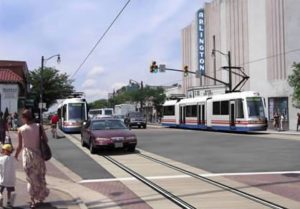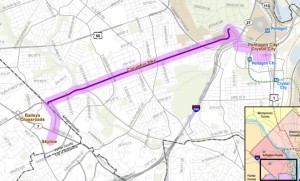 Arlington County’s own Transit Advisory Committee came close last night to passing a resolution supporting articulated bus service on Columbia Pike over the planned Columbia Pike streetcar project.
Arlington County’s own Transit Advisory Committee came close last night to passing a resolution supporting articulated bus service on Columbia Pike over the planned Columbia Pike streetcar project.
The resolution, proposed by committee member Joseph Warren, was ultimately defeated by a vote of 6-5, but not before a spirited debate among committee members. Citing a county-funded alternatives analysis, streetcar opponents on the committee made their case for why enhanced bus service — including higher-capacity articulated buses and a limited number of fixed stops along the Pike between Pentagon City and the Skyline section of Fairfax County — is a better option.
“Articulated bus [is] a practical and far more cost-effective alternative than the modified streetcar,” Warren said in his resolution, which his read aloud.
“Streetcar costs range from $249-261 million compared with $39-68 million for TSM 2 [articulated bus service]. The annual operating cost for the streetcar is $25.6 million compared to $22.1 million for the for the TSM 2 articulated bus,” Warren said. “Yet… [projected] streetcar ridership is only 4-6 percent greater than [articulated bus service].”
 “Travel times of the modified streetcar and [articulated buses] are nearly identical and both operate in mixed traffic,” Warren continued. “However, since streetcars could not pass obstacles such as illegally parked cars and vehicles moving in and out of parking spaces, it is much more vulnerable to delays.”
“Travel times of the modified streetcar and [articulated buses] are nearly identical and both operate in mixed traffic,” Warren continued. “However, since streetcars could not pass obstacles such as illegally parked cars and vehicles moving in and out of parking spaces, it is much more vulnerable to delays.”
Committee member John Antonelli, who lives along the Pike, echoed Warren’s concerns about the reliability of streetcar service.
“If we were talking about a Metro subway under Columbia Pike… my opinion on this issue would be very different than what it is today,” said Antonelli. “Instead we’re talking about a trolley on steel wheels… a system that can be brought down by ice, wind, snow… by one mis-parked car or road crew. The articulated bus won’t have all the strictures of steel wheels on steel rails. It can move around things. It can be had for a whole lot cheaper, with the same benefits.”
But committee member Franz Gimmler said helping people get from one place to another isn’t the only thing that should be considered when planning transit service. He said economic development and enhanced livability are two important benefits that will come with a Columbia Pike streetcar line, but not with enhanced bus service.
“There’s a growing recognition that transportation is not in and of itself the end,” Gimmler said. “The end is what transportation does to your community, what it provides in building a community.”
“Arlington County has been fortunate that an earlier generation of leaders had a vision for the county that led them to fight for Metrorail underneath Wilson Boulevard,” he continued. “As a result, the Rosslyn-Ballston corridor is a internationally-recognized example of the best of transit-oriented development. We are fortunate that our current leaders have learned from that transit project and have envisioned the same benefits for the Columbia Pike corridor.”
“The light rail alternative is the only alternative that will bring livability to the Pike and achieve the vision established for the corridor, and I am convinced that the outcome is worth the anticipated cost,” Gimmler said. “As a resident of north Arlington, I’m willing to pay the cost of the rail alternative. Even though I will not benefit directly, I know that everybody along the Pike paid for my livable community along the Orange Line, now it’s my time to pay for theirs along Columbia Pike.”
In response, streetcar opponents questioned whether the streetcar would truly bring practical economic benefits to those who live along the Pike, as the alternatives analysis suggests.
“Development is happening on Columbia Pike right now, before the trolley has even shown up,” said Antonelli. “Would a nice trolley help a developer sell ticky-tacky condos on Columbia Pike? Sure. But here’s the thing that’s going to increase livability on Columbia Pike… it’s efficient, reliable transit.”
Arlington County Transit Bureau Chief Stephen Del Giudice, who spoke at last night’s committee meeting, said that project consultants believe the the streetcar will, in fact, raise property values along the Pike.
“The consultants… hypothesize that there will be at least a five percent increase in property values along Columbia Pike,” he said. “In fact, the literature they cite suggests the range can be anywhere between zero and 30 [percent].”
Enhanced bus service, he said, would not provide the same benefit.
“Fixed rail does in fact contribute to property value increases and economic development,” Del Giudice said. “It’s an attraction.”
Some committee members questioned whether the streetcar would raise rents along the Pike, forcing out those who live in what is now market rate affordable housing. Del Giudice said affordability was a major topic of concern at two recent public meetings held to discuss the streetcar. He pointed out, however, that rents are already rising along Columbia Pike, while income is flat. The streetcar, he said, could help the situation by allowing reinvestment along the Pike.
“That additional value in property [from the streetcar] will generate more revenue for the county,” Del Giudice said. “And one of the things that is being recommended [for Columbia Pike] is tax reductions to promote housing and financing assistance. All of those things cost money, but conceivably, the county will have an opportunity to take some of the revenue that is generated by a streetcar investment and reinvest it in the community.”

